英文跨文化交际
跨文化交际英文版8 Understanding Culture
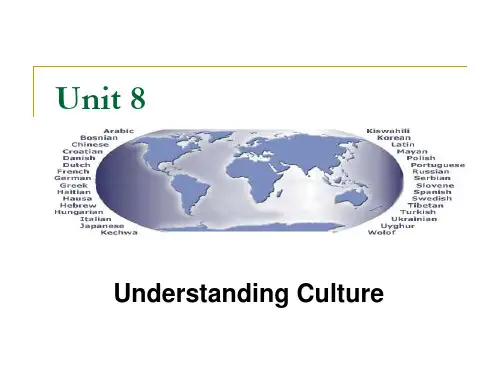
What is Culture
That complex whole which includes knowledge, belief, art, law, morals, custom and any otheired by man as a member of society. ---Edward B. Tylor
Define culture from different perspectives
From Intellectual Perspective From Anthropological Perspective From Social Perspective From Intercultural Communication Perspective
From Social Perspective
Culture is what a society does and thinks.
Culture covers everything of a society.
From Intercultural Communication Perspective
Culture is a learned set of shared interpretations about beliefs, values, and norms, which affect the behavior of a relatively large group of people.
Movie to Watch
Mexican American Culture vs. Anglo-Saxon Culture
Self-check List
(完整版)跨文化交际英文版
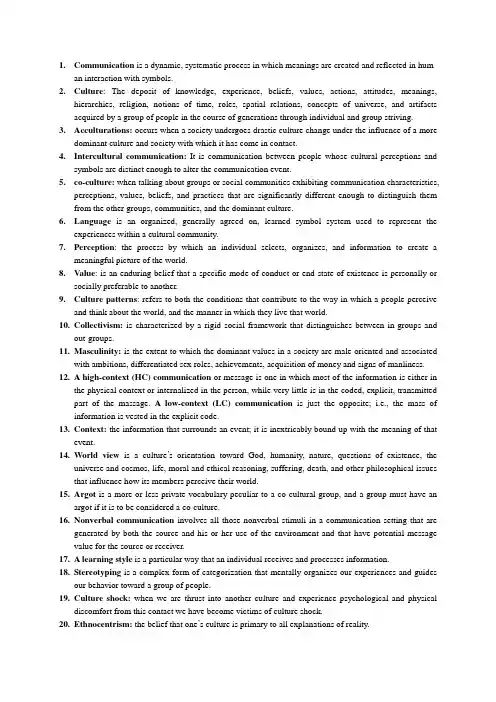
munication is a dynamic, systematic process in which meanings are created and reflected in human interaction with symbols.2.Culture: The deposit of knowledge, experience, beliefs, values, actions, attitudes, meanings,hierarchies, religion, notions of time, roles, spatial relations, concepts of universe, and artifacts acquired by a group of people in the course of generations through individual and group striving.3.Acculturations: occurs when a society undergoes drastic culture change under the influence of a moredominant culture and society with which it has come in contact.4.Intercultural communication:It is communication between people whose cultural perceptions andsymbols are distinct enough to alter the communication event.5.co-culture: when talking about groups or social communities exhibiting communication characteristics,perceptions, values, beliefs, and practices that are significantly different enough to distinguish them from the other groups, communities, and the dominant culture.nguage is an organized, generally agreed on, learned symbol system used to represent theexperiences within a cultural community.7.Perception: the process by which an individual selects, organizes, and information to create ameaningful picture of the world.8.Value: is an enduring belief that a specific mode of conduct or end-state of existence is personally orsocially preferable to another.9.Culture patterns: refers to both the conditions that contribute to the way in which a people perceiveand think about the world, and the manner in which they live that world.10.Collectivism:is characterized by a rigid social framework that distinguishes between in-groups andout-groups.11.Masculinity: is the extent to which the dominant values in a society are male oriented and associatedwith ambitions, differentiated sex roles, achievements, acquisition of money and signs of manliness. 12.A high-context (HC) communication or message is one in which most of the information is either inthe physical context or internalized in the person, while very little is in the coded, explicit, transmitted part of the massage. A low-context (LC) communication is just the opposite; i.e., the mass of information is vested in the explicit code.13.Context: the information that surrounds an event; it is inextricably bound up with the meaning of thatevent.14.World view is a culture’s orientation toward God, humanity, nature, questions of existence, theuniverse and cosmos, life, moral and ethical reasoning, suffering, death, and other philosophical issues that influence how its members perceive their world.15.Argot is a more or less private vocabulary peculiar to a co-cultural group, and a group must have anargot if it is to be considered a co-culture.16.Nonverbal communication involves all those nonverbal stimuli in a communication setting that aregenerated by both the source and his or her use of the environment and that have potential message value for the source or receiver.17.A learning style is a particular way that an individual receives and processes information.18.Stereotyping is a complex form of categorization that mentally organizes our experiences and guidesour behavior toward a group of people.19.Culture shock: when we are thrust into another culture and experience psychological and physicaldiscomfort from this contact we have become victims of culture shock.20.Ethnocentrism: the belief that one’s culture is primary to all explanations of reality.21.Seven characteristics of culture affect communication: learned, transmitted from generation togeneration, based on symbols, dynamic, integrated, ethnocentric, adaptive.22.Belief: our conviction in the truth of something. Learned and subject to cultural interpretation andcultural diversity.23.Individualism:refers to the doctrine, spelled out in detail by the seventeenth. The single mostimportant pattern in the US.24.Hofstede’s Value Dimensions:four parts: individualism-collectivism, uncertainty avoidance, powerdistance, and masculinity and femininity.25.Culture differs in their attitudes toward: individualism and collectivism, uncertainty avoidance,power distance, masculinity and femininity, human nature, the perception of nature, time, activity, relationships, context, formality and informality, assertiveness and interpersonal harmony.26.Religious Similarities: sacred writings, authority, traditional rituals, speculation, ethics.27.Five religious orientations: Christianity, Judaism, Islam, Hinduism, Buddhism.28.the family we are born into the family of orientation and take a spouse the family of procreation.29.problems of translation and equivalence:vocabulary or lexical equivalence, idiomatic and slangequivalence, grammatical-syntactical equivalence, experiential-cultural equivalence, conceptual equivalence.30.The use of argot reflects a co-culture’s need to have a language that permits them to 1.sharemembership,2. participate in their social and cultural communities,3. identify themselves and their place in the universe, 4. communicate with one another about their own social realities.31.Functions of communication: repeating, complementing, substituting, regulating, contradicting.32.The study of how movement communicates is called kinesics. Kinesic cues are those visible bodyshifts and movements that can send messages about 1.our attitude toward the other person 2. our emotional state 3. our desire to control our environment.33.Eyes serve six communication functions: 1. indicates degree of attentiveness, interest, and arousal 2.help intiate and sustain intimate relationships 3. influence attitude change and persuasion 4. regulate interaction 5. communicate emotions 6. define power and status relationships 7. assume a central role in impression management.34.kinds of vocalizations: vocal characterizers, vocal qualifiers, vocal segregates.。
(完整版)跨文化交际英文版

munication is a dynamic, systematic process in which meanings are created and reflected in human interaction with symbols.2.Culture: The deposit of knowledge, experience, beliefs, values, actions, attitudes, meanings,hierarchies, religion, notions of time, roles, spatial relations, concepts of universe, and artifacts acquired by a group of people in the course of generations through individual and group striving.3.Acculturations: occurs when a society undergoes drastic culture change under the influence of a moredominant culture and society with which it has come in contact.4.Intercultural communication:It is communication between people whose cultural perceptions andsymbols are distinct enough to alter the communication event.5.co-culture: when talking about groups or social communities exhibiting communication characteristics,perceptions, values, beliefs, and practices that are significantly different enough to distinguish them from the other groups, communities, and the dominant culture.nguage is an organized, generally agreed on, learned symbol system used to represent theexperiences within a cultural community.7.Perception: the process by which an individual selects, organizes, and information to create ameaningful picture of the world.8.Value: is an enduring belief that a specific mode of conduct or end-state of existence is personally orsocially preferable to another.9.Culture patterns: refers to both the conditions that contribute to the way in which a people perceiveand think about the world, and the manner in which they live that world.10.Collectivism:is characterized by a rigid social framework that distinguishes between in-groups andout-groups.11.Masculinity: is the extent to which the dominant values in a society are male oriented and associatedwith ambitions, differentiated sex roles, achievements, acquisition of money and signs of manliness. 12.A high-context (HC) communication or message is one in which most of the information is either inthe physical context or internalized in the person, while very little is in the coded, explicit, transmitted part of the massage. A low-context (LC) communication is just the opposite; i.e., the mass of information is vested in the explicit code.13.Context: the information that surrounds an event; it is inextricably bound up with the meaning of thatevent.14.World view is a culture’s orientation toward God, humanity, nature, questions of existence, theuniverse and cosmos, life, moral and ethical reasoning, suffering, death, and other philosophical issues that influence how its members perceive their world.15.Argot is a more or less private vocabulary peculiar to a co-cultural group, and a group must have anargot if it is to be considered a co-culture.16.Nonverbal communication involves all those nonverbal stimuli in a communication setting that aregenerated by both the source and his or her use of the environment and that have potential message value for the source or receiver.17.A learning style is a particular way that an individual receives and processes information.18.Stereotyping is a complex form of categorization that mentally organizes our experiences and guidesour behavior toward a group of people.19.Culture shock: when we are thrust into another culture and experience psychological and physicaldiscomfort from this contact we have become victims of culture shock.20.Ethnocentrism: the belief that one’s culture is primary to all explanations of reality.21.Seven characteristics of culture affect communication: learned, transmitted from generation togeneration, based on symbols, dynamic, integrated, ethnocentric, adaptive.22.Belief: our conviction in the truth of something. Learned and subject to cultural interpretation andcultural diversity.23.Individualism:refers to the doctrine, spelled out in detail by the seventeenth. The single mostimportant pattern in the US.24.Hofstede’s Value Dimensions:four parts: individualism-collectivism, uncertainty avoidance, powerdistance, and masculinity and femininity.25.Culture differs in their attitudes toward: individualism and collectivism, uncertainty avoidance,power distance, masculinity and femininity, human nature, the perception of nature, time, activity, relationships, context, formality and informality, assertiveness and interpersonal harmony.26.Religious Similarities: sacred writings, authority, traditional rituals, speculation, ethics.27.Five religious orientations: Christianity, Judaism, Islam, Hinduism, Buddhism.28.the family we are born into the family of orientation and take a spouse the family of procreation.29.problems of translation and equivalence:vocabulary or lexical equivalence, idiomatic and slangequivalence, grammatical-syntactical equivalence, experiential-cultural equivalence, conceptual equivalence.30.The use of argot reflects a co-culture’s need to have a language that permits them to 1.sharemembership,2. participate in their social and cultural communities,3. identify themselves and their place in the universe, 4. communicate with one another about their own social realities.31.Functions of communication: repeating, complementing, substituting, regulating, contradicting.32.The study of how movement communicates is called kinesics. Kinesic cues are those visible bodyshifts and movements that can send messages about 1.our attitude toward the other person 2. our emotional state 3. our desire to control our environment.33.Eyes serve six communication functions: 1. indicates degree of attentiveness, interest, and arousal 2.help intiate and sustain intimate relationships 3. influence attitude change and persuasion 4. regulate interaction 5. communicate emotions 6. define power and status relationships 7. assume a central role in impression management.34.kinds of vocalizations: vocal characterizers, vocal qualifiers, vocal segregates.。
跨文化交际 英文作文
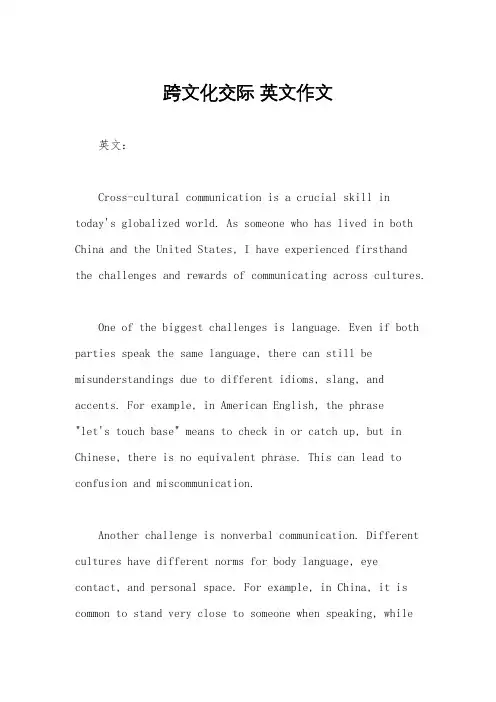
跨文化交际英文作文英文:Cross-cultural communication is a crucial skill intoday's globalized world. As someone who has lived in both China and the United States, I have experienced firsthandthe challenges and rewards of communicating across cultures.One of the biggest challenges is language. Even if both parties speak the same language, there can still be misunderstandings due to different idioms, slang, and accents. For example, in American English, the phrase"let's touch base" means to check in or catch up, but in Chinese, there is no equivalent phrase. This can lead to confusion and miscommunication.Another challenge is nonverbal communication. Different cultures have different norms for body language, eye contact, and personal space. For example, in China, it is common to stand very close to someone when speaking, whilein the United States, people tend to maintain more distance. This can make people from different cultures feel uncomfortable or even offended.However, when cross-cultural communication is done well, it can be incredibly rewarding. It can lead to new friendships, business opportunities, and a deeper understanding of different cultures. For example, when Iwas living in China, I made friends with a local family who invited me to their home for dinner. They taught me about Chinese customs and traditions, and I was able to share my own culture with them. It was a wonderful experience that would not have been possible without cross-cultural communication.中文:跨文化交际是当今全球化世界中至关重要的技能。
跨文化交际 英文作文
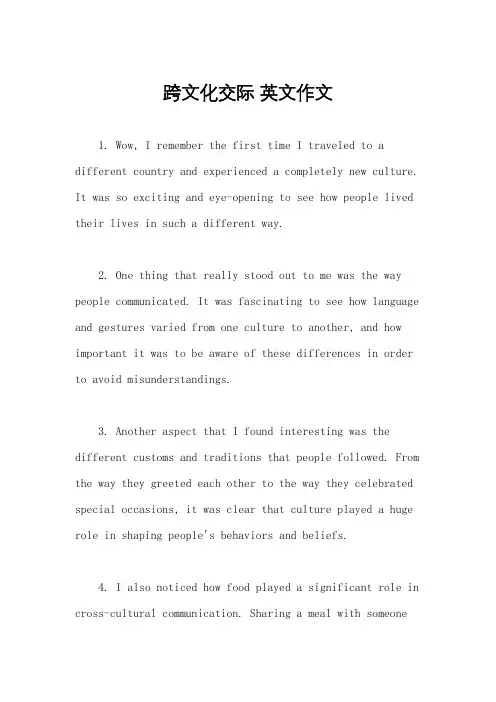
跨文化交际英文作文1. Wow, I remember the first time I traveled to a different country and experienced a completely new culture. It was so exciting and eye-opening to see how people lived their lives in such a different way.2. One thing that really stood out to me was the way people communicated. It was fascinating to see how language and gestures varied from one culture to another, and how important it was to be aware of these differences in order to avoid misunderstandings.3. Another aspect that I found interesting was the different customs and traditions that people followed. From the way they greeted each other to the way they celebrated special occasions, it was clear that culture played a huge role in shaping people's behaviors and beliefs.4. I also noticed how food played a significant role in cross-cultural communication. Sharing a meal with someonefrom a different culture was a great way to connect and learn more about their background and values.5. Overall, my experiences with cross-cultural communication have taught me to be more open-minded and respectful of others' differences. It's important to approach new cultures with curiosity and a willingness to learn, rather than judgment or preconceived notions.。
有关跨文化交际英文作文
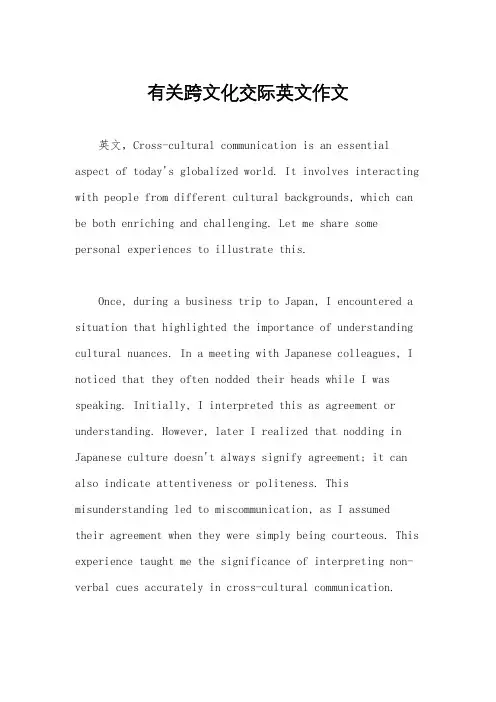
有关跨文化交际英文作文英文,Cross-cultural communication is an essential aspect of today's globalized world. It involves interacting with people from different cultural backgrounds, which can be both enriching and challenging. Let me share some personal experiences to illustrate this.Once, during a business trip to Japan, I encountered a situation that highlighted the importance of understanding cultural nuances. In a meeting with Japanese colleagues, I noticed that they often nodded their heads while I was speaking. Initially, I interpreted this as agreement or understanding. However, later I realized that nodding in Japanese culture doesn't always signify agreement; it can also indicate attentiveness or politeness. This misunderstanding led to miscommunication, as I assumedtheir agreement when they were simply being courteous. This experience taught me the significance of interpreting non-verbal cues accurately in cross-cultural communication.Another instance occurred during a cultural exchange program in Brazil. While conversing with locals, I noticed they often stood close to me and used expressive gestures. At first, I felt uncomfortable with the proximity, as personal space boundaries vary across cultures. However, I gradually adapted and even found it refreshing to engage in such close, animated conversations. This experience taught me the importance of respecting and adapting to different cultural norms, even if they initially seem unfamiliar.中文,跨文化交际在今天全球化的世界中至关重要。
英文跨文化交际
A 14. Language is important because it _____ • A. helps us shape concepts, controls how we think, and controls how we perceive others. • B. allows us to be understood by foreigners. • C. is determined by colonialism. • D. is stable, easily understood, and free of diversity. 15. The opinion that everyone has a position and clearly defined privileges is _____. A • A. a view of hierarchical structure of social relationship • B. a view of group orientation structure of social relationship • C. a view of individual orientation structure of social relationship • D. none of the above 16. Proverbs are significant to the study of intercultural communication because_______. D • A. they provide a compact description of a culture’s values • B. they tell a great deal about what a culture praises and what it rejects • C. they unite a people with the wisdom of their ancestors • D. all of the above
英语跨文化交际(英文论文)
1.Digest................................................................................................................................... P22.The key word ..................................................................................................................... P23.The main body ................................................................................................................. P24.The c onclusion.................................................................................................................. P45.Acknowledgment ......................................................................................................... P4Economic g lobalization h as b rought m ore o pportunities f or C hinese t o e ncounter a nd communicate with f oreigners.However,there a re u psetting p roblems a rising,with t he intercultural c ommunication gaining i ts o wn p opularity.Not j ust r anging f rom t he background of c ulture t o t he s tereotype o f thinking,but t he p atriotism a nd t he ethnocentrism in i ndividual m ind,are a ll o bstacles,in t he s ake f or building e ffective a nd precise communication b etween d ifferent c ulture.Therefore,we a re s upposed t o utilize t he scientist m ethods t o h andle a s eries o f t ypical p roblems.ntercultural c ommunication;the s tereotype o f t hinking;cultural exchangeEven if t he i ndividuals t alk w ith e ach o ther i n t he s ame l anguage,we s till c annot make sure t hat t he can c atch t he c orrect a nd p recise m eanings f orm o thers.It’s b ecause the w ay t hey t hink i s d istinct,the background o f c ulture t hey l ive i n i s d ifferent a nd t he method they u se t o h andle t rouble d iffers f rom ones.Moreover,due t o t he c ultural conflicts and o bstacles,the c ommunications t end t o b e accompanied b y misunderstandings and d istortions i n t he c urrent c onditions.So w hen i t comes t o communication dilemma,p eople t end t o j udge t he b ehaviors a nd w ords o f o thers i n t heir own c ultural acknowledgment,which makes intercultural communication with obvious patriotism and e thnocentrism.With t he d egree o fintercultural c ommunication g rowing,b etween d ifferent c ultures will have a certain d egree o fmutual p enetration.F or e xample,common w ords,s uch a svitamin,the I nternet a nd r adar a re t he d irect t ransliteration o fEnglish.W ords s uch a s Kung Fu,the p aper tiger a nd l ose f ace h ad j oined i nto t he O xford D ictionary.O bviously,with the p rocess o f c ultural e xchange, cultural r epresentation i n t he p roperty r eached a stage o fmutual u nderstanding,t hen f ollowed m ust b e deeper c ultural i ntegration.We n eed t o b reak t he s tereotype o fintercultural c ommunication,.Forexample,majority of C hinese t hink A mericans m ay b e i n f avor o findividualism b ut A sian prefer collectivism.Actually,f acts i s n ot s o.In O yserman’s r esearches,A mericans i n m any field m ore p refer t he m odel of c ollectivism,l ike t he g rade s ystem,a nd m aintaining groups’pared with t hat,Japanese just l ike s uch c ollectivism l ike w orking i n the group.A lso,people u sually t hink A rab t alkingwith o thers w ill sit n early,which m eans they can s mell p ersonal o dor a nd f requently t ouch o thers b ody s how t heir enthusiasm.However,according t o d escriptions o fpeople w ho l ived i n A rab c ountries,t his i s n ot t he case.T hey s ay A rab d o n ot s it n early a ny m ore w hen t alking.Obviously,i fwe i ntend t o clear up t he obstacles o fintercultural c ommunication,u nderstanding t he s tatus q uo i s t he top priority.O therwise,t he efforts o f e stablishing o n p revious c oncepts a nd i deas a re i n vain.The conclusion:Overall,intercultural c ommunication i s i nevitable i n t he g lobal e conomic environment.Then, how t o c ommunicate i n a e fficient a nd a ccurate w ay,i t s till n eeds explore and p ractice.W e m ust m ake clear t hat r educing b arriers i n i ntercultural communication is n ot t hat o ne s ubmits t o t he o ther,but the p eople e ntirely u nderstand their own c ulture a nd t hen l ook f or c ultural c ommon a nd a ttributes between t wocultures.Initial communication i s b ased o n t he c ommon t hing,then w ith t he t alk deeper,the attributes w ould m ake t he c onversation g o o n.[1]Oyserman, D. Coon, H. M. & Kemmelmeier, M. Rethinking individualism and collectivism:Evaluation of theoretical assumptions a nd m eta-analyses[J].Psychological B ulletin,2002,128:3-72.写作能力是对自己所积累的信息进行选择、提取、加工、改造并将之形成为书面文字的能力。
跨文化交际的英文表达
"Cross-cultural communication" 是指在不同文化背景下进行交流和理解的过程。
在许多情境下,人们可能会用以下表达来描述跨文化交际:
1. Intercultural Communication: 跨文化交际的常用术语。
2. Cultural Exchange: 文化交流,表示在不同文化间分享和交流信息。
3. Global Communication: 全球交流,指的是超越国界进行的跨文化沟通。
4. Diversity and Inclusion: 多元性与包容,强调在交际中考虑和尊重不同文化的多样性。
5. Interpersonal Understanding: 人际理解,强调在交流中理解和尊重他人的文化差异。
6. Cultural Sensitivity: 文化敏感性,指的是在交际中考虑并尊重他人的文化背景。
7. Adaptation and Adjustment: 适应与调整,表示在不同文化环境中调整自己的交际方式以融入当地文化。
8. Global Citizenship: 全球公民意识,鼓励个体在跨文化交际中具有开放、包容和全球意识。
9. Cultural Intelligence (CQ): 文化智商,强调个体在不同文化中有效交往的能力。
10. Bridging Cultural Divides: 架桥文化分歧,表示尝试弥合不同文化间的差异。
在任何跨文化交际中,理解文化差异的重要性以及尊重他人文化的价值观是关键。
这些表达可以帮助描述和促进在多元文化背景中的有效交际。
跨文化交际 英文ppt
•
American culture is individualistic (个人主义)culture, and it is the culture of "small power distance".
Thank you!
——张和玉
Question • 1.Why does Li Ming stand up suddenly? • 2.Why his boss will misunderstand his behavior?
This is mainly because of the power distance(权力距离). Most individualistic(个人主义) culture is also a “small power distance” culture. People with such cultural backgrounds(背景) tend to think that all men are created equal(人人平等) In such a culture, often not because of age, seniority(辈分), on the lower level of the difference between the both sides of communication differential(区别) treatment(对待) of each other.
No Stand-up When Your Leader Comes In
•
I’m Li Ming. I worked in an American company. When my boss came into my office for the first time, I stood up immediately(立即) to show my respect. The boss misunderstood my behavior, thought I was going out, and said he would tail with me in a while. I was accustomed (习惯) to respecting all those in authority.
- 1、下载文档前请自行甄别文档内容的完整性,平台不提供额外的编辑、内容补充、找答案等附加服务。
- 2、"仅部分预览"的文档,不可在线预览部分如存在完整性等问题,可反馈申请退款(可完整预览的文档不适用该条件!)。
- 3、如文档侵犯您的权益,请联系客服反馈,我们会尽快为您处理(人工客服工作时间:9:00-18:30)。
9. Culture and language are intertwined and shape each other. And it is impossible to separate the two. T 10 In short, intercultural communication competence requires sufficient awareness knowledge, motivations, and skills. Each of these components alone is sufficient to achieve intercultural communication competence. F
A 14. Language is important because it _____ • A. helps us shape concepts, controls how we think, and controls how we perceive others. • B. allows us to be understood by foreigners. • C. is determined by colonialism. • D. is stable, easily understood, and free of diversity. 15. The opinion that everyone has a position and clearly defined privileges is _____. A • A. a view of hierarchical structure of social relationship • B. a view of group orientation structure of social relationship • C. a view of individual orientation structure of social relationship • D. none of the above 16. Proverbs are significant to the study of intercultural communication because_______. D • A. they provide a compact description of a culture’s values • B. they tell a great deal about what a culture praises and what it rejects • C. they unite a people with the wisdom of their ancestors • D. all of the above
5. All cultures require and value politeness, but the ways in which politeness is achieved may vary significantly. T 6. If you are a college student or a graduate student and meet during the break in an academic conference an American professor who is a friend of your supervisor's, you can go over and have a talk with him as long as the break permits. F 7. A culture’s conception of time can be examined from two different perspectives: Monochronic Time (M-Time) and Polychronic Time (P-Time) F 8. Addressing forms like “Miss Mary”, “Brown” by the Chinese may be a form of cultural compromise. T
B 17. Tina: “Wow, look at all the things on sales. __________” Andrew: “Yes. Look, this shirt is 50% off.” Tina: “And look at these shoes. They are 30% off the normal price.” A. I’d like to buy a shirt. B. There are some real bargains. C. Are the prices reasonable? D. These shoes are the same as mine. B 18. In China, if a Tibetan communicates with a Han, it is ___. A. interracial communication. B. interethnic communication. C. international communication. D. interpersonal communication. 19. Jack phones Xiao Song’s office. Jack: “Hello, I’d like to speak to Song Hua, please.” Song: B . • A .“I’m Song Hua.” B. “This is Song Hua speaking.” • C. “This is me.” D. “It’s me here.”
20. Asked by a western host to make a choice of drink, you normally say: ____________. C • A. No, no, no. Don’t bother. (Actually you are thirsty.) • B. Up to you. (Hoping to make things easier for the host.) • C. Tea, please. (Tea is also offered and you prefer it.) • D. Tea, please. (But don't drink it.) 21. Mr. Green’s secretary, Pat Kent, went to the airport to meet Mr. Barnes for her boss. • Miss Kent: . D • A. “Excuse me, would you be Mr. Barnes?” • B. “Are you Mr. Barnes?” • C. “You are Mr. Barnes, aren’t you?” • D. “Excuse me, would you please tell me if you are Mr. Barnes?” 22.You’ve just been asked out to dinner but you don’t want to go with the person who invited you. You might say: D . • A. “I don’t think so. I already have plans.” • B. “No, I really don’t enjoy being with you.” • C. “I’m dieting so I mustn’t go out to eat.” • D. “Thanks a lot but I’m busy tonight.”
11. Xiao Ma is an interpreter. One day a foreign visitor, Mr. Brown, talks to him. Mr. Brown: “Your English is quite fluent.” Ma: . A • A. “Thank you. It is kind of you to say so.” • B. “No, not at all.” • C. “No, no, my English is poor.” • D. “Oh, no. Far from that, I still have a long way to go.” 12. When you are asked to sit on a sofa in an English home, it is appropriate for you to say ___ C _. • A. No, no, I’ll sit here. (Sitting down on a chair.) • B. No, no, this chair is perfectly all right. You sit there. • C. Thank you. (Taking a seat; you don’t choose to be modest.) • D. Thank you. (But choose to sit down on a chair.) 13. Bob: “Hi Jane. How are you?” • Jane: “ ___ I didn’t sleep a wink (合眼)last night. A • The people next door were making a lot of noise again till very late at night.” • A. I’m feeling a bit out of sorts(不高兴的) this morning. • B. Fine, thank you. And you? • C. I slept like a log and didn’t want to get out of bed. • D. It seems a bit unusual, you know.
